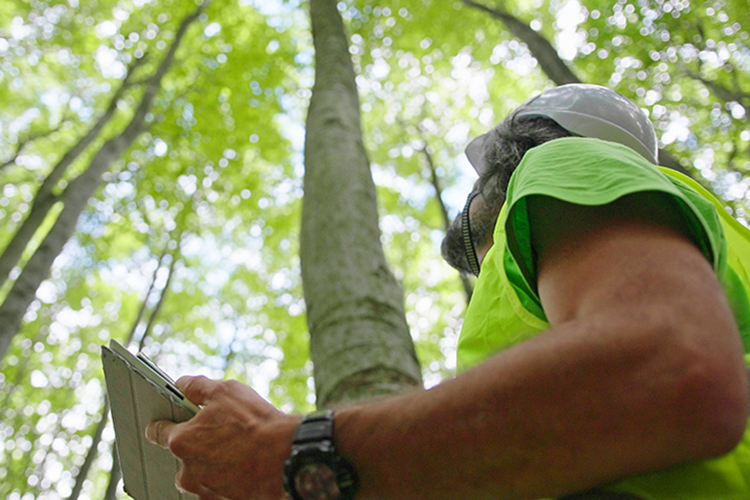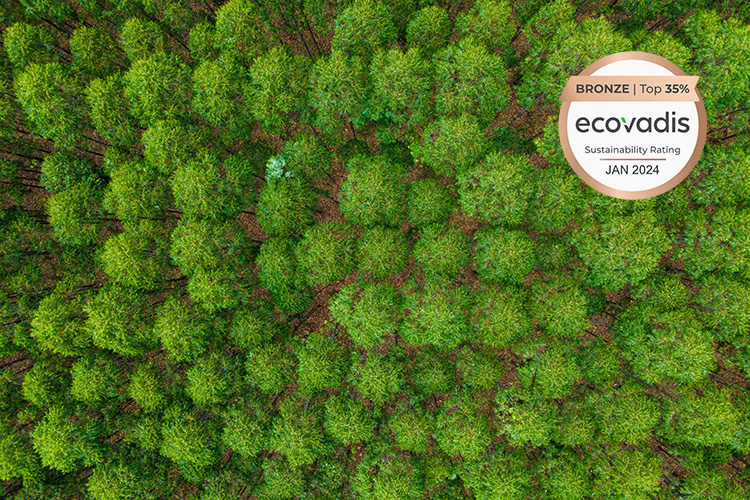Energy
Energy is vital to the papermaking process, and we are proud of our efforts to reduce energy consumption. We generate more than 80% of our total mill energy needs from renewable, carbon-neutral biomass residuals, reducing our reliance on fossil fuels. Biomass residuals are the by-products from converting a tree into cellulose pulp.
Biogenic Carbon Cycle

Trees absorb CO2 from the atmosphere and as they decay, biogenic carbon is released back to the atmosphere. This natural cycle is balanced, so atmospheric CO2 levels remain unchanged.
Sylvamo Energy Sources Summary

Residual biomass is used to generate more than 80% of our mill energy needs, releasing biogenic carbon back to the atmosphere. The cycle repeats as working forests are sustainably managed to continuously produce fiber for future harvests.
Breakdown of Our Global Fuel Consumption:
86 %
Total Biogenic Fuel Use
14 %
Fossil Fuels
Emissions
Sylvamo has a responsibility as a public company to steward our footprint within the communities we operate. It is critical that we measure and disclose emission inventory annually to demonstrate our commitment to climate action. One of our responsible operations targets is to reduce our greenhouse gas (GHG) emissions within the facilities that we own and operate.
Sylvamo has a 2030 GHG absolute reduction goal of 35% with a 2019 baseline year, across all three scopes*. To calculate our target, we used the Science Based Target initiative’s (SBTi) calculator and selected the absolute contraction method, under the “well below two degrees Celsius” scenario; this was validated by SBTi in 2023. SBTi validated a “well below 2 degree” absolute reduction target across all 3 scopes in early 2023 and we disclose progress in our annual sustainability performance review report, along with our annual CDP submission.
*Scope 3 emissions include Categories 1, 3, 4, 6 and 7
"SBTi approval is a major accomplishment for such a young organization. We know the future of paper deserves a company committed to the success of the entire ecosystem. This is one more example of how our 2030 goals highlight our commitment to producing paper in the most responsible and sustainable ways."

James McDonald
Chief Sustainability Officer
Emissions
(Scope 1, 2 and 3)
Total gross Scope 1, 2 and 3 emissions by region (metric tons CO2e)
| Europe | |
|---|---|
| Scope 1 Emissions | 99,745 |
| Scope 2 Emissions* | 3,891 |
| Scope 3 Emissions** | 337,910 |
| Latin America | |
|---|---|
| Scope 1 Emissions | 121,886 |
| Scope 2 Emissions* | 34,286 |
| Scope 3 Emissions** | 521,104 |
| North America | |
|---|---|
| Scope 1 Emissions | 477,926 |
| Scope 2 Emissions* | 49,883 |
| Scope 3 Emissions** | 740,398 |
**Scope 3 emissions include categories 1, 3, 4, 6 and 7
| Scope 1 Emissions | Scope 2 Emissions* | Scope 3 Emissions** | |
|---|---|---|---|
| Europe | 99,745 | 3,891 | 337,910 |
| Latin America | 121,886 | 34,286 | 521,104 |
| North America | 477,926 | 49,883 | 740,398 |











